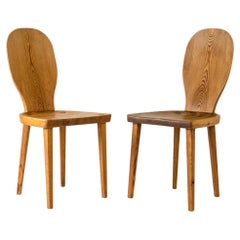Skedblad Chair
Recent Sales
Early 20th Century Swedish Scandinavian Modern Chairs
Pine
Vintage 1930s Scandinavian Modern Side Chairs
Pine
Early 20th Century Danish Scandinavian Modern Dining Room Chairs
Pine
Vintage 1930s Swedish Chairs
Pine
Carl Malmsten for sale on 1stDibs
Carl Malmsten, a prominent furniture designer and educator associated with Swedish modernism, enjoyed immense popularity for his shapely sofas and armchairs in luscious color palettes. Malmsten believed that light — much like our eyes and bodies — doesn’t like to bump into sharp objects. Smooth edges, on the other hand, are kinder to the eye and and to our touch, and allow light to softly bounce off surfaces. Malmsten felt that if his furniture didn’t “serve well” in the home, it had no business being there.
Malmsten’s career essentially began in 1915, when his submissions for a competition to furnish the new Stockholm City Hall were first- and second-place prize winners. In the 1920s, his profile soared. He won a prize at the International Exhibition of Modern Decorative and Industrial Arts — the show that brought the Art Deco style to worldwide attention — and quickly became one of the most sought-after designers of commercial seating in Sweden.
Malmsten was soon contracted to design chairs, tables and other furniture for the Stockholm Concert Hall, the Swedish Institute in Rome and the Waldorf Astoria hotel in New York. His famous Art Nouveau-influenced Stadshusstolen chair, designed for Stockholm City Hall in 1916, is a highlight of the city’s recently opened Museum of Furniture Studies. Malmsten expanded into interior design and created a luxurious, well-appointed living room in the palace of then-Crown Prince Gustaf Adolf and his bride, Crown Princess Louise.
In the 1930s, Malmsten clashed with critics when he voiced his opposition to functionalism. Like Danish modernist Kaare Klint, he favored using quality local materials and prized traditional craftsmanship. Malmsten’s furniture draws on graceful neoclassical influences, and he said that extreme functionalism contributed to “sterile” interiors — while the curving contours of his work may share ground with furniture designed by Alvar Aalto or Bruno Mathsson, Malmsten differed with Bauhaus eminences and some Scandinavian modernists on their prioritization of functionalism.
For an exhibition in 1956 at the Röhsska Museum in Gothenburg, Malmsten designed furniture that was intended for mass production — and his striking designs began to make their way into middle-class Swedish homes owing to Malmsten’s partnerships with manufacturers such as O.H. Sjögren. Until then, he had built his pieces at the school he founded in the 1930s or had them made by artisans at several small local workshops.
Malmsten founded a number of schools for design and collaborated with other designers who shared his philosophy of “hand and mind in creative collaboration.” These included the esteemed textile artist Märta Måås Fjetterström, whose pieces he included in exhibits and even his own home.
On 1stDibs, find vintage Carl Malmsten seating, tables, cabinets and more.
Finding the Right seating for You
With entire areas of our homes reserved for “sitting rooms,” the value of quality antique and vintage seating cannot be overstated.
Fortunately, the design of side chairs, armchairs and other lounge furniture — since what were, quite literally, the early perches of our ancestors — has evolved considerably.
Among the earliest standard seating furniture were stools. Egyptian stools, for example, designed for one person with no seat back, were x-shaped and typically folded to be tucked away. These rudimentary chairs informed the design of Greek and Roman stools, all of which were a long way from Sori Yanagi's Butterfly stool or Alvar Aalto's Stool 60. In the 18th century and earlier, seats with backs and armrests were largely reserved for high nobility.
The seating of today is more inclusive but the style and placement of chairs can still make a statement. Antique desk chairs and armchairs designed in the style of Louis XV, which eventually included painted furniture and were often made of rare woods, feature prominently curved legs as well as Chinese themes and varied ornaments. Much like the thrones of fairy tales and the regency, elegant lounges crafted in the Louis XV style convey wealth and prestige. In the kitchen, the dining chair placed at the head of the table is typically reserved for the head of the household or a revered guest.
Of course, with luxurious vintage or antique furnishings, every chair can seem like the best seat in the house. Whether your preference is stretching out on a plush sofa, such as the Serpentine, designed by Vladimir Kagan, or cozying up in a vintage wingback chair, there is likely to be a comfy classic or contemporary gem for you on 1stDibs.
With respect to the latest obsessions in design, cane seating has been cropping up everywhere, from sleek armchairs to lounge chairs, while bouclé fabric, a staple of modern furniture design, can be seen in mid-century modern, Scandinavian modern and Hollywood Regency furniture styles.
Admirers of the sophisticated craftsmanship and dark woods frequently associated with mid-century modern seating can find timeless furnishings in our expansive collection of lounge chairs, dining chairs and other items — whether they’re vintage editions or alluring official reproductions of iconic designs from the likes of Hans Wegner or from Charles and Ray Eames. Shop our inventory of Egg chairs, designed in 1958 by Arne Jacobsen, the Florence Knoll lounge chair and more.
No matter your style, the collection of unique chairs, sofas and other seating on 1stDibs is surely worthy of a standing ovation.

